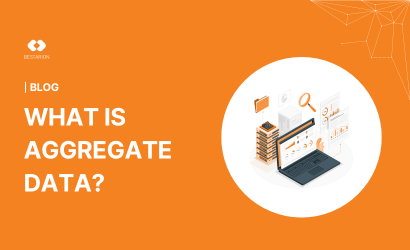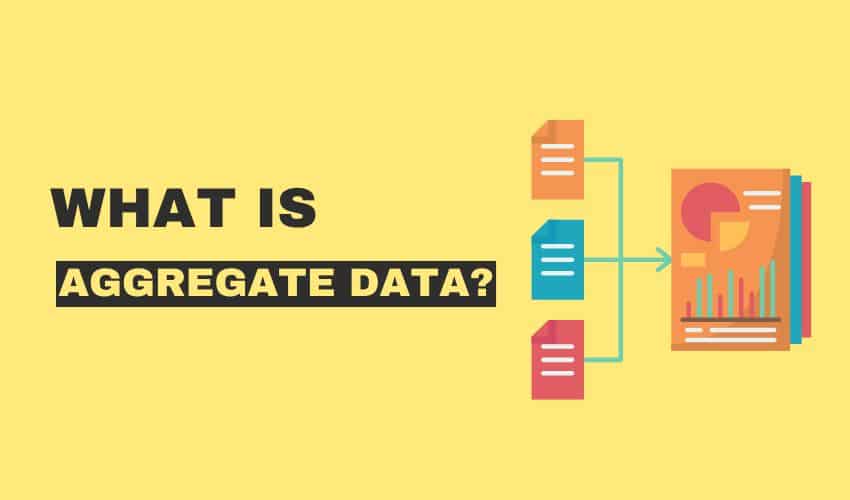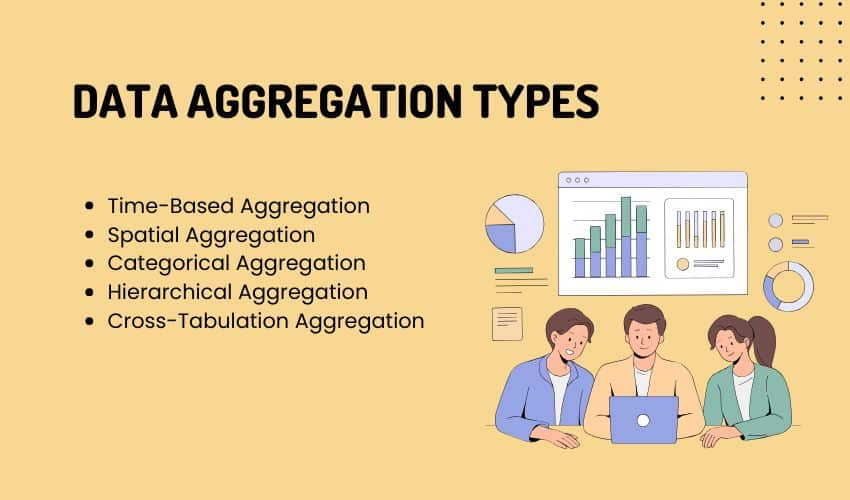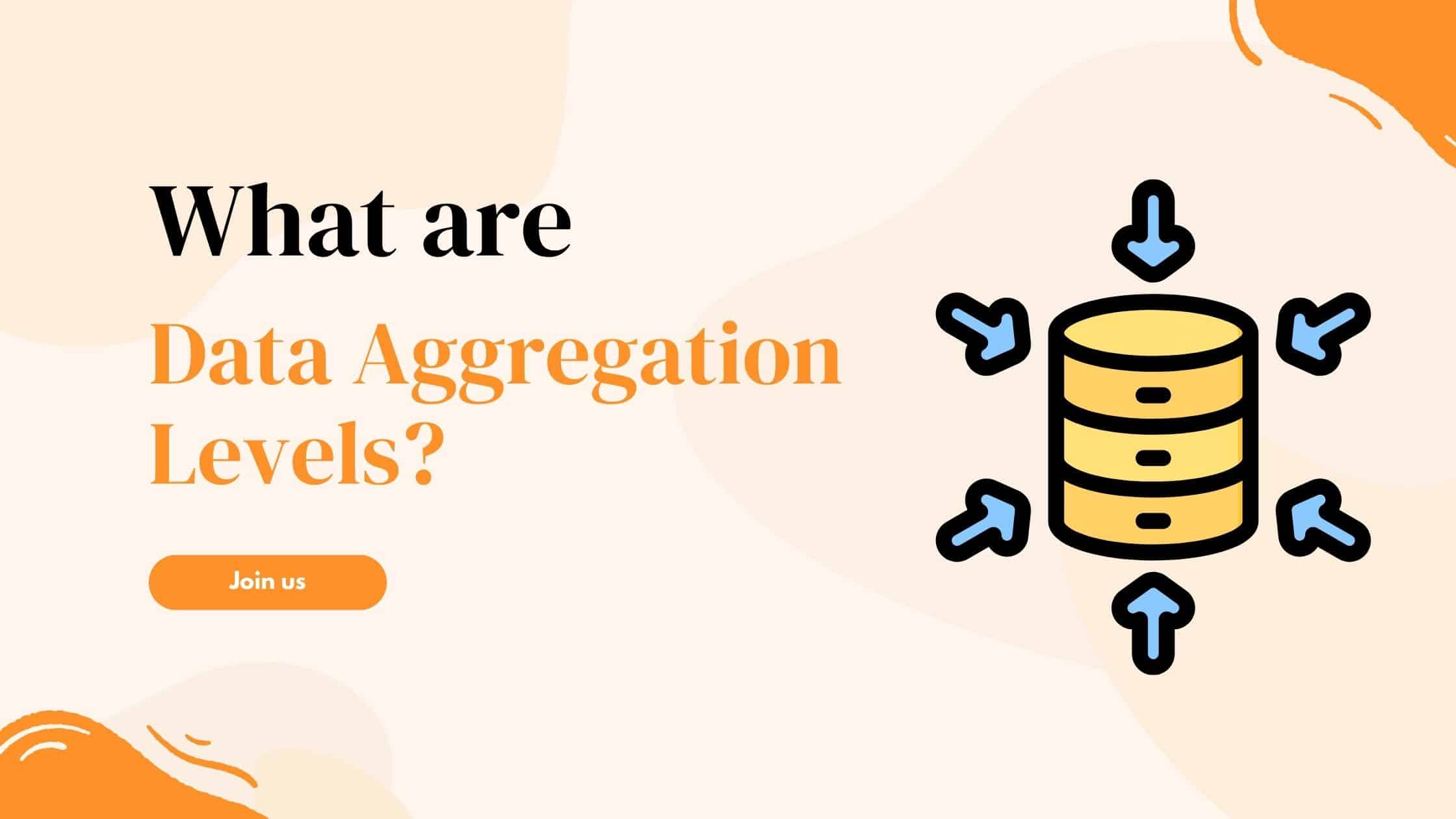Aggregate Data: A Comprehensive Overview


Large-scale data collection offers valuable insights for businesses, researchers, and governments. One method analysts use to harness these insights is data aggregation, which helps in making predictions, evaluating processes, and guiding decision-making. The concept of aggregate data plays a critical role across various sectors, including business, healthcare, finance, and more.
In this article, we will explore the concept of aggregate data, its significance, and provide examples of how various industries utilize this type of data. Additionally, we will discuss the differences between aggregate and disaggregate data.
Key Takeaways:
- Aggregate data summarizes complex information, making it easier to spot trends and guide decisions.
- Different aggregation types and levels serve various analytical needs, from daily reports to big-picture insights.
- Data accuracy and ethics matter – poor-quality or biased data can lead to misleading results.
- Use both aggregate and disaggregate data for a balanced view—overview plus detailed insights.
What is Aggregate Data?
Aggregate data refers to data that is collected and compiled from multiple sources and presented in summary form. Unlike raw data, which consists of individual data points, aggregate data combines these points to provide a comprehensive overview. This summarization can involve various forms of data manipulation, such as averaging, summing, or categorizing.
For example, in a business context, a company might collect sales data from different stores. Instead of analyzing each transaction, the company could aggregate the data to determine the total sales per store, region, or product category. This aggregated information helps in making strategic decisions without being overwhelmed by the volume of raw data.
What are the data aggregation types?
Data aggregation can take various forms, each tailored to support specific analytical needs. Understanding these types helps organizations choose the most suitable approach for their goals. Here are five common types of data aggregation:
- Time-Based Aggregation: This involves summarizing data over time intervals—daily, monthly, or yearly. It’s especially useful for identifying patterns, seasonal fluctuations, and long-term trends, helping businesses monitor growth and forecast future performance.
- Spatial Aggregation: Spatial aggregation organizes data by geographical location, such as city, region, or country. It’s widely used in areas like urban development, healthcare analysis, and market research to reveal regional differences and spatial patterns.
- Categorical Aggregation: This method groups data based on defined categories like age, income level, or industry sector. It enables comparisons across segments and helps uncover trends within specific demographic or behavioral groups—for example, analyzing customer buying habits by age group.
- Hierarchical Aggregation: Hierarchical aggregation summarizes data across different levels of a hierarchy while allowing the ability to drill down into more detailed layers. It’s particularly useful in organizations with complex structures or nested data sets.
- Cross-Tabulation Aggregation: Also known as contingency table analysis, this method aggregates data across two or more categorical variables to examine relationships or correlations. It’s often used in survey analysis or behavioral research to explore how variables interact.
What Are Data Aggregation Levels?
Data can be aggregated at varying levels depending on the level of detail or granularity needed for analysis. The primary levels include:
- Micro Aggregation: This involves collecting data at its most detailed level—such as individual records or transactions. While it provides highly specific insights, it often demands significant computing power and processing time, especially with large datasets.
- Meso Aggregation: Meso-level aggregation represents a middle ground. It organizes data into groups or subcategories, making it easier to spot patterns and trends without getting lost in granular details. This level offers a balance between detail and clarity.
- Macro Aggregation: At this highest level, data is summarized to present an overall picture, highlighting broad trends and overall performance. While it’s useful for strategic decision-making, this approach may obscure finer details or variances within the dataset.
Why Aggregate Data is Matter?
Data aggregation involves summarizing data from multiple sources, providing capabilities for various aggregate measurements such as sum, average, and count. Data aggregators perform this summarization, transforming detailed data into a consolidated format that is easier to analyze and interpret.
Aggregate data is commonly stored in data warehouses, which helps in answering analytical queries efficiently and significantly reducing the time required to query large datasets.
Data aggregation is widely used for statistical analysis of groups and to produce valuable summary information for business analysis. This process is typically carried out on a large scale using software tools known as data aggregators. These tools are equipped with features for collecting, processing, and presenting aggregated data.
By using data aggregation, analysts can access and analyze vast amounts of data within a reasonable timeframe. A single row of aggregated data can represent hundreds or thousands of individual data records. This allows for quicker querying of the aggregated data, eliminating the need to process each underlying data row in real-time during queries.
As organizations continue to store increasing amounts of data, aggregating the most important and frequently accessed data becomes essential. This makes it feasible to retrieve and analyze the data efficiently.
Examples of Aggregate Data:
- Voter Turnout by State or County: Instead of presenting individual voter records, the total votes for each candidate in a specific region are summarized.
- Average Age of Customers by Product: The average age of customers for each product is calculated and saved, without identifying individual customers.
- Number of Customers by Country: Instead of examining each customer individually, the total number of customers in each country is presented.
Data aggregation can also achieve a similar effect to data anonymization. Individual data elements with personally identifiable details are combined and replaced with a summary representing a group as a whole. For example, instead of browsing through individual employee records with salary data, a summary showing the average salary by department can be created.
Aggregate data doesn’t need to be numeric. For instance, you can count the number of occurrences of any non-numeric data element.
Importance of Data Accuracy Before Aggregation
Before aggregating data, it’s crucial to ensure the atomic data is accurate and sufficient for the aggregation to be meaningful. For example, counting votes when only 5% of the results are available is unlikely to produce a relevant aggregate for prediction. The reliability of aggregate data depends heavily on the quality and completeness of the underlying raw data.
Read more: Cloud Data Warehouses: The Future of Data Management
How Do Data Aggregators Work?
Data aggregators operate by gathering detailed data from various sources, processing it to derive meaningful insights, and presenting the aggregated information in a summary format. They typically offer capabilities to track data lineage, allowing users to trace back to the original data. The process can be broken down into several key steps:
1. Collection
- Data Extraction: The initial step involves extracting data from diverse sources and storing it as atomic data in large databases. These sources can include:
- Social Media Communications: Posts, comments, likes, and shares.
- News Headlines: Articles, bulletins, and news updates.
- Personal Data from IoT Devices: Browsing history, location data, and sensor information.
- Call Centers and Podcasts: Transcriptions and audio data through speech recognition technology.
- Data Storage: The extracted data is stored in a format that facilitates efficient processing and retrieval.
2. Processing
- Identification of Atomic Data: The data aggregator identifies which data points need to be aggregated.
- Analytical Techniques: Predictive analytics, artificial intelligence (AI), or machine learning algorithms may be applied to the collected data to extract new insights and patterns.
- Aggregation: Specified statistical functions (such as sum, average, count) are applied to the data to create meaningful summaries.
3. Presentation
- Summary Format: The aggregated data is presented in a summarized format that highlights the derived insights. This can be in the form of tables, charts, dashboards, or reports.
- Comprehensive Results: The statistical results are comprehensive and high-quality, enabling users to make informed decisions.
Manual vs. Automated Aggregation
Manual Aggregation:
- Involves manually collecting, processing, and summarizing data.
- Feasible on a small scale but prone to errors, omissions, and inefficiencies.
- Less suitable for large datasets due to the potential for inaccuracies and the time-consuming nature of the process.
Automated Aggregation:
- Utilizes data aggregators to automate the process.
- Significantly reduces the risk of errors and enables the handling of vast amounts of data efficiently.
- More adept at identifying patterns and insights that might be missed manually.
Applications of Aggregate Data
Data aggregation is invaluable across various disciplines, offering critical insights that inform decision-making, strategy development, and operational efficiency. Here are some key uses of data aggregation:
- Business and Marketing: Companies use aggregate data to understand market trends, customer behavior, and sales performance. By analyzing aggregated sales data, businesses can identify which products are performing well and which are not, helping them to make informed decisions on inventory management, marketing strategies, and product development.
- Healthcare: In the healthcare sector, aggregate data is used for epidemiological studies, resource allocation, and policy-making. For instance, during the COVID-19 pandemic, aggregated data on infection rates, hospitalizations, and vaccinations played a crucial role in guiding public health responses.
- Finance: Financial institutions rely on aggregate data to assess economic conditions, monitor market trends, and evaluate risk. Aggregated financial data, such as average credit scores or total loan defaults, helps banks and investors make better-informed decisions.
- Education: Schools and universities use aggregate data to evaluate student performance, assess educational outcomes, and allocate resources. By examining aggregated test scores and graduation rates, educational institutions can identify areas needing improvement and develop targeted interventions.
- Public Policy: Governments and policy-makers use aggregate data to shape public policy and allocate resources effectively. For example, census data, which is aggregated from individual responses, informs decisions on infrastructure development, public services, and funding allocations.
Users of Aggregated Data
Aggregated data is utilized by various professionals, including:
- Data Analysts: They analyze aggregated data to uncover trends, patterns, and insights that inform business decisions.
- Data Scientists: They apply advanced analytics and machine learning techniques to aggregated data to predict future trends and outcomes.
- Data Warehouse Administrators: They manage the storage and retrieval of aggregated data, ensuring data integrity and accessibility.
- Subject Matter Experts: They use aggregated data to gain insights specific to their field, supporting strategic planning and decision-making.
Examples of Aggregated Data in Use
- Statistical Analysis: Aggregated data is commonly used for statistical analysis to obtain information about specific groups based on demographic or behavioral variables such as age, profession, education level, or income. This information can be crucial for market research, policy-making, and social studies.
- Business Analysis: Companies aggregate user data from various sources, including social media communications, browsing history from IoT devices, and other personal data. This aggregated data provides a comprehensive view of consumer behavior, helping businesses tailor their strategies to meet market demands and improve customer satisfaction.
Benefits of Using Aggregate Data
- Simplification and Clarity: Aggregate data simplifies complex datasets by summarizing them, making it easier to interpret and analyze large volumes of information. This clarity helps stakeholders make more informed decisions quickly.
- Trend Identification: Aggregating data allows for the identification of trends and patterns that might not be apparent in individual data points. Recognizing these trends is crucial for strategic planning and forecasting.
- Resource Allocation: By providing a high-level overview, aggregate data helps organizations allocate resources more efficiently. For example, hospitals can use aggregated patient data to determine where to deploy medical staff and equipment.
- Privacy Protection: Aggregating data can protect individual privacy by removing personal identifiers. This anonymization is particularly important in sectors like healthcare and finance, where sensitive information is handled.
- Data Comparisons: Aggregate data enables comparisons across different groups, regions, or time periods. This comparative analysis is vital for benchmarking performance and identifying best practices.
Challenges of Using Aggregate Data
- Loss of Detail: One of the main drawbacks of aggregate data is the loss of detail. Important nuances and insights present in individual data points can be overlooked when data is aggregated.
- Potential Biases: Aggregating data can introduce biases, especially if the underlying data is not representative. For instance, if certain demographics are underrepresented in the data collection process, the aggregated results may not accurately reflect the entire population.
- Misinterpretation: There is a risk of misinterpreting aggregate data if the context is not fully understood. Decision-makers might draw incorrect conclusions if they are not aware of the limitations or assumptions behind the aggregated data.
- Data Quality: The accuracy of aggregate data depends on the quality of the raw data. Inaccurate, incomplete, or inconsistent data can lead to misleading aggregate results.
- Overgeneralization: Aggregate data can lead to overgeneralization, where unique characteristics of sub-groups are overlooked. This can result in policies or strategies that are not effective for all segments of the population.
Aggregate Data vs. Disaggregate Data
Aggregate Data and Disaggregate Data are two different approaches to organizing and analyzing data. Here’s a breakdown of their differences and uses:
Aggregate Data
Aggregate Data |
Disaggregate Data |
|
| Definition |
|
|
| Characteristics |
|
|
| Examples |
|
|
| Uses |
|
|
| Advantages |
|
|
| Disadvantages |
|
|
Choosing Between Aggregate and Disaggregate Data
The choice between aggregate and disaggregate data depends on the purpose of the analysis:
- Aggregate Data is suitable for high-level overviews, strategic planning, and identifying general trends.
- Disaggregate Data is essential for in-depth analysis, personalized insights, and detailed research.
In many cases, both types of data can complement each other. Aggregate data provides the big picture, while disaggregate data fills in the details.
Ethical Considerations
- Privacy and Confidentiality: While aggregate data can protect individual privacy, it is essential to ensure that the aggregation process truly anonymizes the data. Care must be taken to prevent re-identification, where individuals could be identified from aggregated data combined with other information.
- Transparency: Organizations should be transparent about how aggregate data is collected, processed, and used. This transparency helps build trust and ensures that stakeholders understand the limitations and potential biases of the data.
- Fair Representation: It is crucial to ensure that aggregate data fairly represents all relevant groups. Efforts should be made to collect data from diverse sources and to avoid biases that could result in unfair or discriminatory outcomes.
- Informed Consent: When collecting data, especially from individuals, informed consent is vital. Participants should be aware of how their data will be used, including any plans for aggregation and the purposes for which the aggregated data will be employed.
- Responsible Use: Organizations must use aggregate data responsibly, ensuring that it is used to promote positive outcomes and not to harm individuals or groups. This involves careful consideration of the potential impacts of decisions made based on aggregated data.
Best Practices for Using Aggregate Data
- Ensure Data Quality: Focus on collecting high-quality data to improve the accuracy and reliability of aggregate data. This includes regular data cleaning, validation, and verification processes.
- Use Appropriate Aggregation Techniques: Choose aggregation techniques that align with the goals of the analysis. For example, using median values might be more appropriate than mean values in the presence of outliers.
- Maintain Transparency: Document and communicate the methodologies used for data aggregation, including any assumptions, limitations, and potential biases. This transparency helps stakeholders understand the context and make better-informed decisions.
- Regularly Review and Update Data: Aggregate data should be regularly reviewed and updated to reflect current conditions. Stale or outdated data can lead to incorrect conclusions and poor decision-making.
- Balance Detail and Aggregation: Strive to find a balance between detailed data and aggregated summaries. Where possible, provide access to both aggregated data and the underlying details to allow for deeper analysis when needed.
- Ethical Considerations: Always consider the ethical implications of data aggregation, including privacy, consent, and fair representation. Implement measures to protect individual privacy and avoid biases.
Conclusion
Aggregate data is a powerful tool that offers numerous benefits across various sectors, from business and healthcare to finance and public policy. By summarizing complex datasets, it provides clarity, facilitates trend identification, and aids in resource allocation. However, the use of aggregate data also comes with challenges, including the potential loss of detail, biases, and ethical considerations.
To maximize the benefits and minimize the drawbacks, organizations must adopt best practices for data aggregation, ensuring high data quality, transparency, and ethical use. As technology advances, the capabilities for analyzing and leveraging aggregate data will continue to grow, offering new opportunities for informed decision-making and improved outcomes.






